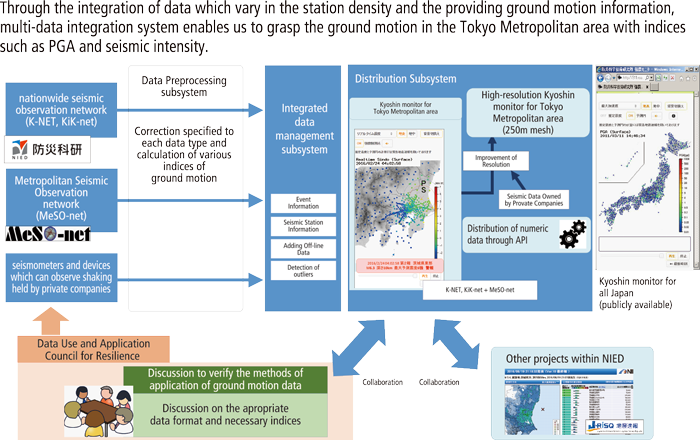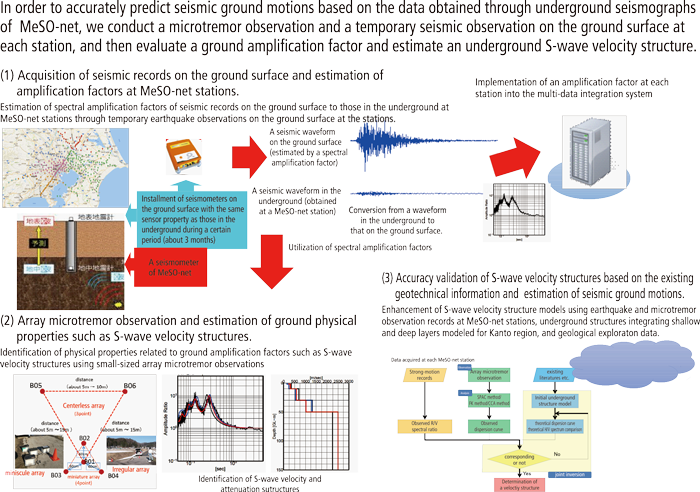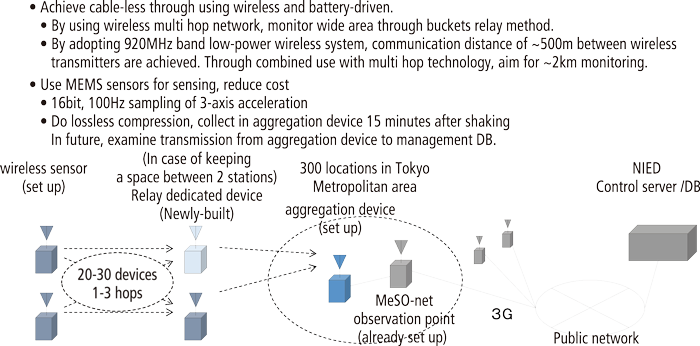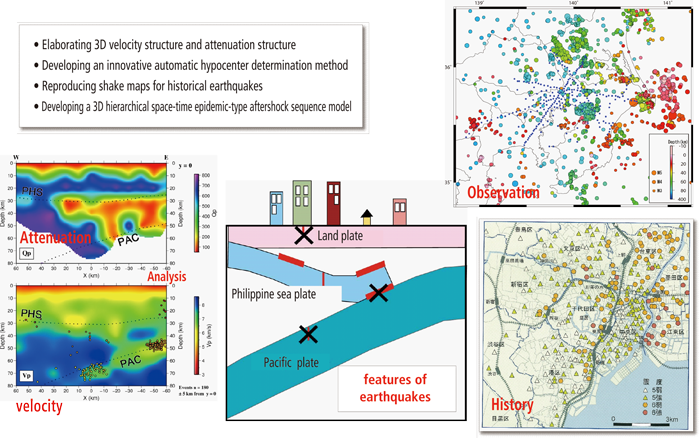R&D Activities - Subprojects(b)
Natural science field Aiming to improve predictive capability
Collection and integration of ultra high-density ground motion data through public-private cooperation.
Stably operating the Metropolitan Seismic Observation network (MeSO-net), Subproject (b) develops multi-data integration sysytem to integrate seismic data from NIED seismic networks such as nationwide observation networks for earthquakes, tsunamis and volcanoes over land and sea (MOWLAS) and MeSO-net with a large amount of the shaking data held by private companies, and to make the information products produced from the integrated data available. In order to collect dense observation data, techniques to observe shaking using smartphones and to transmit observed data from satellite devices to MeSO-net stations are developed. To evaluate seismic hazards in Tokyo Metropolitan area, we understand seismic activity from past to present, and develop prediction methods for ground motion caused by large earthquakes in future.
Research Themes
1
Collection of ultra high-density ground motion data through public-private cooperation
We manage and accumulate seismic data of MeSO-net which is deployed at the Tokyo Metropolitan area with station intervals of several kilo-meters and has recorded ground motion continuously. Some stations are located densely on linear arrays to understand seismicity beneath the Tokyo Metropolitan area. In order to reduce the observation noise due to human activities in the Tokyo Metropolitan area, the seismometer of MeSO-net is installed at the bottom of borehole whose depth was 20 m, and most of MeSO-net stations are placed at elementary and junior high schools where the seismic noise is relatively low in the urban area.

2a
Development of multi-data integration system
We develop a multi-data integration system to receive and integrate high-density seismic observation data from MeSO-net and strong motion observation data from MOWLAS. We calculate ground motion on the surface from the MeSO-net borehole data to obtain high-density distributions of the strong motion on the ground. Moreover, we integrate shaking data held by private companies with NIED observed data, and develop information distributing system such as Kyoshin monitor for the Tokyo Metropolitan area.

2b
Estimation of earthquake ground motions at the surface of MeSO-net stations
Using seismometers with the same sensor property as those of MeSO-net stations, we conduct an array microtremor observation and an analysis at each MeSO-net station. Also, we acquire earthquake observation records on the ground surface over a fixed time period and study amplification factors of seismic motions on the ground surface to those observed by MeSO-net seismometers E330in the underground. And then, we identify S-wave velocity structures based on array microtermor records through validating accuracy of them and tuning them, and estimate seismic waveforms on the ground surface.

2c
Developing strong motion observation techniques using smartphones
We publicly seek applicants from households and corporations in the Tokyo Metropolitan Area, and attach terminals-ready-for-use in order to formulate an operating structure to upgrade observation techniques. We conduct multiple simultaneous connection tests on servers to confirm effectiveness during large-scale deployment and implement prototype development of transmission system using API etc. Based on feedback from monitors, we conduct verification for improving utilization rate, while developing visualization techniques aimed at returning results to monitors. Regarding the data transmission and collection system, we clarify issues for continuing stable operation.

2d
Developing transmission techniques for shaking data between MeSO-net observation points - satellite observation point clusters
We examine trigger functions, wireless data transmission functions and low power consuming techniques necessary for transmitting shaking data at satellite observation points. We manufucture prototype wireless shaking data transmitters, implement trial observation at MeSO-net observation points, and research for enduring long-term observation. We improve based on trial observation, and verify performance.

2e
Clarifying past/future portrait of earthquakes in Tokyo Metropolitan Area
PI: Ryou Honda, Senior researcher, Hot Springs Research Institute of Kanagawa
We reveal the plate structure and the 3D attenuation structure beneath the Metropolitan area and Izu region by using seismic data observed by MeSO-net and other observation networks. We also reveal the completeness magnitude and the 3D distributions of b-value from the earthquake catalog determined by using dense seismic observation networks including MeSO-net. Moreover, we develop a multivariate analysis algorithm for hypocenter determination considering spatial correlations in a statistical manner after scrutinization of conventional algorithms. Parameter estimation program codes based on machine learning are implemented. An automated hypocenter determination method which is able to apply for the Metropolitan area is upgraded according to results of analysis using huge amount of low quality seismic data. Seismic velocity structures beneath the Metropolitan area and Izu region are revealed based on integrated seismic activity data from past to present. We develop a 3D hierarchical space-time epidemic-type aftershock sequence model and investigate for a highly accurate prediction method of seismic-intensity distribution.


